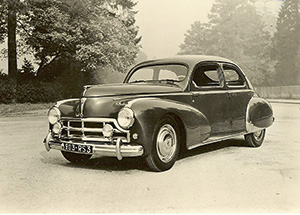-
MenuBack
-
COLLECTIONS
-
-
24h00 Le Mans
-
Alpine A110 1600S
-
Lancia 037
-
-
-
FULL KIT
-
-
FULL KIT
-
-
- ACCESSORIES
- Australian
- MAQMADON
-
Assembly guides
-
-
Blog Ixo
-
- FAQ
The Peugeot 203 Darl' Mat
This was not the Parisian tuner's first experience with models produced by the Sochaux-based manufacturer. Already before the war, a Peugeot 302 Darl'Mat Sport had set several records at Montlhéry in 1937 and the following year, Charles de Cortanze and Marcel Contet had won the 2-litre category at the 24 Hours of Le Mans at the wheel of a Peugeot 402 prepared by Darl'Mat.
In the aftermath of the Second World War, most French manufacturers presented new economical and popular models: Renault had its 4CV, Citroën its 2CV, Panhard its Dyna and Simca its Série 8. Peugeot was not to be outdone with its new 203 family saloon presented at the Paris Salon in October 1948. This robust and comfortable model, as the reputation of the cars from Sochaux demands, is far from the characteristics of a sports car. Nevertheless, Émile Darl'Mat chose it as his next racing car, adding a few more horsepower to the engine and modifying the bodywork to make it more aerodynamic.

Like most of the Peugeots previously prepared by Darl'Mat, the 203 was to set records, as here at Montlhéry in 1953.
© IXO Collections SAS - Tous droits réservés. Crédits photo © Archives & Collections Dominique Pascal
Close to series production
Officially presented to the press and dealers in October 1947 at the Salle Wagram in Paris, the 203 was the only new car exhibited on the Peugeot stand at the Motor Show the following year. Marketing of the 203 began in January 1949 and its career ended in February 1960 with 699,863 units built, all versions included. The first vintage of the 203 is available as a saloon with a 7 HP taxable roof, while an 18 cm longer version is available as an option. Darl'Mat chose the 435 cm long short chassis version with a 258 cm wheelbase for its special saloon. As with most Peugeot models previously modified by the Parisian dealer, the chassis and engines of the 203 were produced in the Sochaux factory and then sent to the Darl'Mat workshops in Paris. A total of 135 examples of the 203 Darl'Mat were built between 1949 and 1954, including a few rare convertibles from 1952.

With its large chrome grille, the 203 Darl'Mat inevitably evokes the luxurious American cars of that era.
© IXO Collections SAS - Tous droits réservés. Crédits photo © Peugeot
Lowered chassis
In order to distinguish its special version from the production model, Darl'Mat gave it a more dynamic look by lowering its line by 14 cm. As it was impossible to modify the internal structure of the self-supporting monocoque chassis, he played on the suspension springs, which reduced the ground clearance by 7 cm, but also on the upper parts of the bodywork. To facilitate his work, Darl'Mat obtained the rare privilege of having the Peugeot 203 components delivered to him unassembled, which showed great confidence on the part of the manufacturer. Thus the height of the bonnet, the roof and the glass surfaces were significantly reduced, which enabled the 203 Darl'Mat to benefit from a more efficient Cx and better road holding. In addition, in order to harmonise the bodywork, the rear trunk has been completely redesigned, with a discreet drift, while the wings are chubbier and flanges hide the rear wheels. Numerous accessories and decorative elements have been added, notably the grille inspired by the Cadillac of the moment, framed by large chrome mouldings that house two additional headlights. Great care was taken with the interior, with the adoption of leather upholstery, an elegant steering wheel supplied by Quillery and the possibility of changing the original dashboard instrumentation for Taupin counters.

The Peugeot 203 Dar'lMat is distinguished by its numerous decorative elements: bumpers, hooves and fender crests.
© IXO Collections SAS - Tous droits réservés. Crédits photo © Archives & Collections Dominique Pascal
Advanced engine
The 1,290 cc in-line four-cylinder block of the Peugeot 203 is of modern technical design, receiving in particular a hemispherical Alpax cylinder head with V-shaped overhead valves. Darl'Mat increased the original 42 bhp by improving the compression ratio. To do this, he modified the fuel system by adding a second Solex inverted twin carburettor and fitted a more efficient Nardi intake pipe. At the same time, he modified the exhaust system, which was now equipped with four separate pipes. Power was now 50 bhp and the top speed increased by 15 km/h. For the 1953 model year, the 203 Darl'Mat borrowed the 1,467 cc engine offering 60 bhp from the new 403. Some models were fitted with an optional Constantin supercharger which increased power to 80 bhp at 4,800 rpm and allowed a top speed of 150 km/h. The four-speed gearbox is coupled to a single-plate clutch with a KZ12 elastic hub. A Cotal electromagnetic gearbox is also available as an option.

The dashboard, a bit austere on the original model, is improved with a Quillery steering wheel and the addition of a rev counter.
© IXO Collections SAS - Tous droits réservés. Crédits photo © Archives & Collections
Share this post





 Français
Français Anglais
Anglais Allemand
Allemand Espagnol
Espagnol Italien
Italien Portugal
Portugal